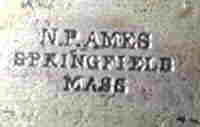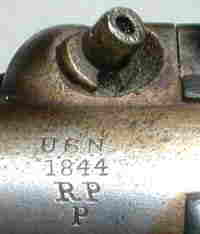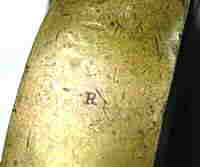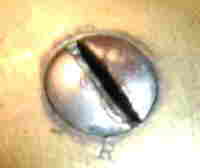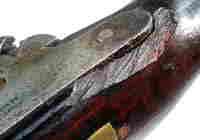| The
N.P. Ames and H. Deringer MODEL 1842 PERCUSSION NAVY PISTOLS (A. K. A. Model 1843 or Navy Box Lock Model 1843)
|
||||
| A
Pair of Old Sea Dogs (With one being a bit "doggier" than the other)
|
||||
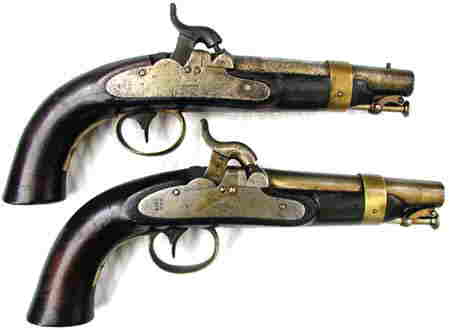
|
||||

|
||||
| Top
- Both Sets of Pictures: 1847 Dated Deringer Navy Pistol
Bottom - Both Sets of Pictures: 1845 Dated Ames Navy Pistol
|
||||
| These
pistols are both .54 caliber smoothbore. The overall measurement,
in a straight line from the heel of the butt to the bottom of the
barrel front, is 12-3/8" for both pieces. The barrel on the Deringer
measures exactly 6" as compared to 5-15/16" for the barrel of the
Ames. Both guns have tangs that measure 1¾" and lockplate
lengths of 4-5/16".
|
||||
|
|
||||
|
The Model 1842 Single Shot Percussion Navy Pistol, caliber .54
smooth bore was manufactured by N.P. Ames, Springfield, Mass. and
Henry Deringer, Philadelphia. from 1842 through 1847. The estimated
total quantities for the Ames production was 2,000 of which all
were delivered to the Navy by 1845. All Ames manufactured pistols
are dated 1842, 1843, 1844 or 1845. With the exception of the first
300, all are virtually the same. The first 300, all dated 1842,
have a flat lock plate with beveled forward edges that terminates,
at the rear, in a point. The 1842 Ames model U.S. Navy pistol represents
the first percussion pistol ever made and delivered under contract
to the U.S. government.
|
||||
|
A second contract for 1,200 Navy pistols was awarded to Deringer
on July 1, 1845. It is generally believed that only 300 of Deringer's
pistols were accepted by the Navy. Deringer purchased the original
manufacturing equipment from Ames to produce his pistols. There
are at least 3 different variations in lockplate markings plus some
barrels were rifled. Experts think the earliest plate markings were
"DERINGER/PHILADEL'A" in two lines using very small letters identical
to the die used to stamp the lockplates on the Model 1817 flintlock
muskets built under contract by Deringer. The second marking added
a relatively large "US" above the small initial stamping. The third
and rarest lockplate marking has the same small stamping, without
the larger "US", but with "U.S.N/1847" in two lines, stamped vertically
to the rear of the lockplate. Barrel markings , if present, may
also differ between examples. The most unusual feature is the inclusion
of 7 groove barrel rifling. These barrels are found only on the
pistols with the large "US" lockplate markings. These pistols are
normally sighted with a fixed "V" notched rear sight mounted on
the tang and a brass post or blade front sight. As such, it represents
the first rifled handgun ever to have been produced for the U.S.
government.
|
||||
|
|
||||

|

|
|||

|

|
|||
|
|
|
|||
|
|
||||
| Ames
Lockplate & Barrel Markings
|
||||
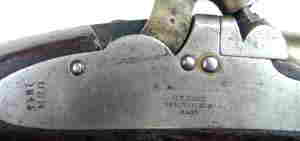
|
||||
|
||||
|
The lockplate is stamped in the center "N.P. AMES/SPRINGFIELD/MASS"
in 3 horizontal lines. At the rear, in 2 vertical lines, is "USN/1845".
The barrel markings are "USN/1844/RP/P" in 4 horizontal stampings.
"RP" stands for the inspector Richard Paine. "P" stands for proofed.
|
||||
|
|
||||
| Other
Ames External Markings
|
||||
|
||||
|
A sub-inspector mark of "R" is stamped on the barrel bolster, the
bottom of the brass trigger guard and on the circular brass butt
plate next to the butt screw.
|
||||
|
|
||||
| A
Look Inside the Ames Lock and Another Marking
|
||||
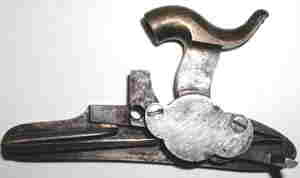
|
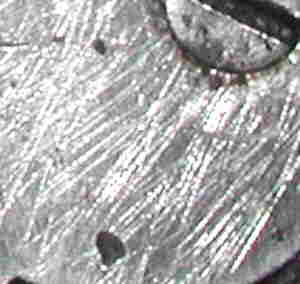
|
|||
|
The "boxed" lock exposed. There is a very small proof or view stamping.
Cannot tell if it is a "P" or a "V". A similar, but hardly legible
marking is on the inside of the Deringer lock (See Deringer details
following).
|
||||
|
|
||||
| Deringer
Lockplate Markings
|
||||

|
||||
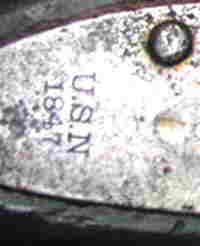
|

|
|||
|
The lockplate is stamped in the center "DERINGER/PHILADEL'A" in
2 horizontal lines. The rear of the lockplate is stamped "U.S.N/1847"
in 2 vertical lines. It is estimated that 50 or less of the Deringer
Navy pistols have this plate marking. There are no other external
stampings on any part of this pistol.
|
||||
|
|
||||
| Inside
The Deringer Lock - Another Marking
|
||||
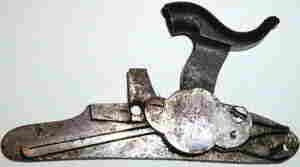
|

|
|||
|
The inside of this "boxlock" pistol is similar if not identical
to the Ames. The stamping could be almost anything but it appears
to be a "V" for "Viewed".
|
||||
|
|
||||
| Miscellaneous
Views
|
||||
|
||||
|
There are no front or rear sights on the Ames pistol. The Deringer
sports a brass front post sight only. As can be seen, the Deringer
pistol has endured tough times. It is pitted, bruised, cracked and
chipped. However, it is supposedly only one of 50 made and may well
be one of the very few or the only one left in existence. In this
case, rarity rules over condition.
|
||||
|
|
||||
| NOTES
|
||||
|
The Model 1842 Percussion Navy pistol served the country for a long
time. They truly seen the world. They were carried by Navy ships
and personnel to Japan, China, Korea, Central America and to every
country visited by U.S. ships of the line. They were on Navy ships
during the War with Mexico. They could be found during the Civil
War on Navy and Army ships and boats maintaining the blockade of
southern ports. They were on board the ships and boats cruising
the Mississippi, Ohio and their tributaries. They very likely were
carried ashore by sailors and marines in landing parties during
that great conflict. Navy records as detailed in "CIVIL WAR SMALL
ARMS OF THE U.S. NAVY AND MARINE CORPS" by John D. McAulay indicate
that both "Navy" and "Army" pistols as well as "Boarding Pistols"
were in evidence, in some numbers, on Naval ships before, during
and at the end of the Civil War. As in the case of the Aston and
Johnson "Army" pistols some even probably found their way into the
Confederate Navy (or Army).
|
||||
|
They are referred to, in Navy records, as "Navy Pistols, Ames Pistols
or Boarding Pistols". "Army Pistols" mentioned in Navy records are
references to the larger size Model 1842, .54 caliber, Single Shot
Pistols manufactured by Henry Aston and Ira N. Johnson from 1845
to 1852.
|
||||
|
Treat them with historical respect. They also served.
|
||||
|
References used for this posting are "UNITED STATES MILITARY SMALL
ARMS 1816 - 1865" by Robert M. Reilly, FLAYDERMAN'S GUIDE TO ANTIQUE
AMERICAN FIREARMS...AND THEIR VALUES" by Norm Flayderman and CIVIL
WAR SMALL ARMS OF THE U.S. NAVY AND MARINE CORPS" by John D. McAulay.
McAulay's book was published in 1999 and provides a wealth of information
for both readers and researchers of the Civil War as well as being
a very valuable book for collectors of U.S. firearms. It is a highly
valuable addition to anyone's reference library and is worthy of
sitting side by side with the great Reilly and Flayderman's books.
This praise is unsolicited and is given out of gratitude and thankfulness
for a work well done and much needed.
|
||||
|
Well, that's it for this week. Next week we will look at one of
the companion pieces to these pistols - the Jenks Carbine With Tape
Primer made by E. Remington & Son, Herkimer, New York.
|
||||
| My
thanks, as usual, to my webmaster and son, Reed Radcliffe.
Dave Radcliffe
|
||||

